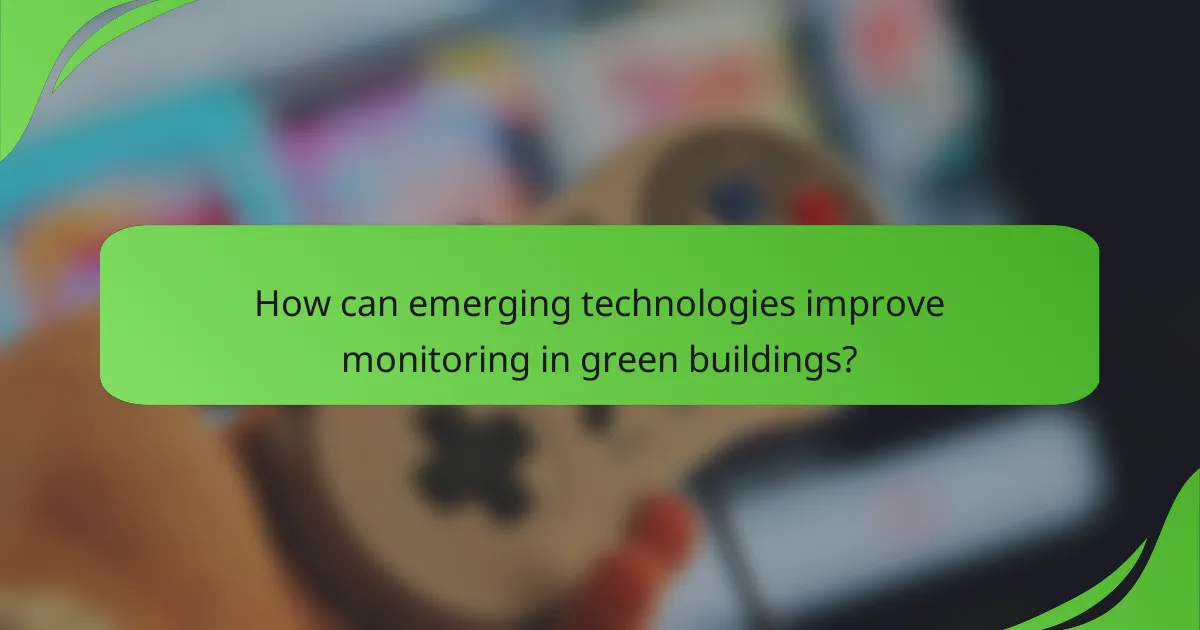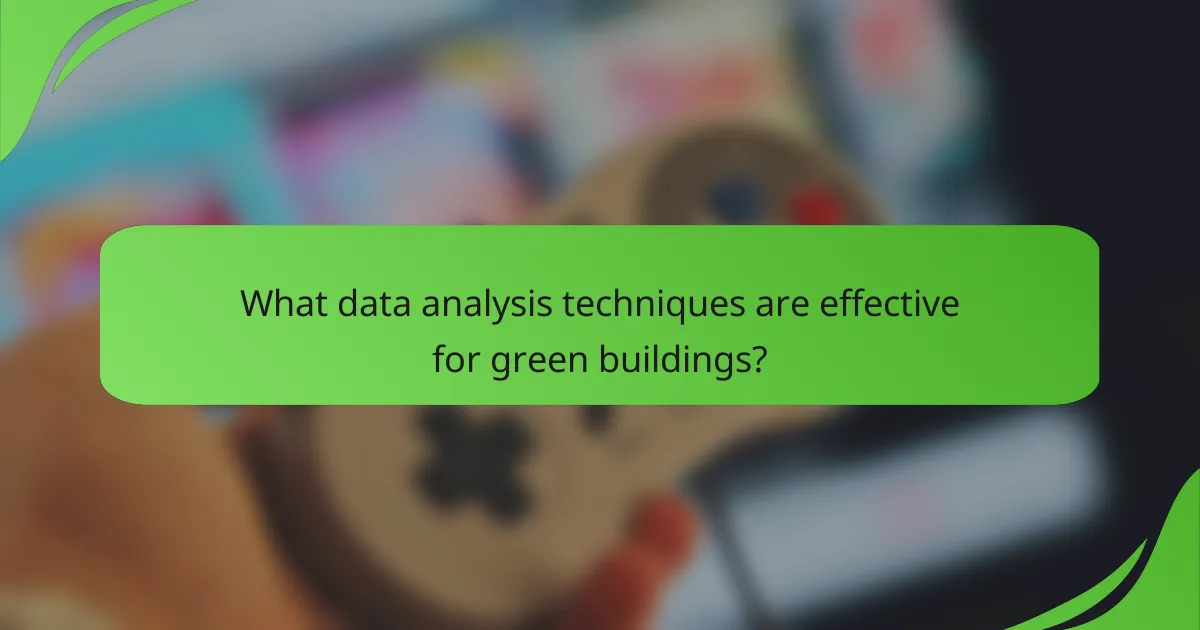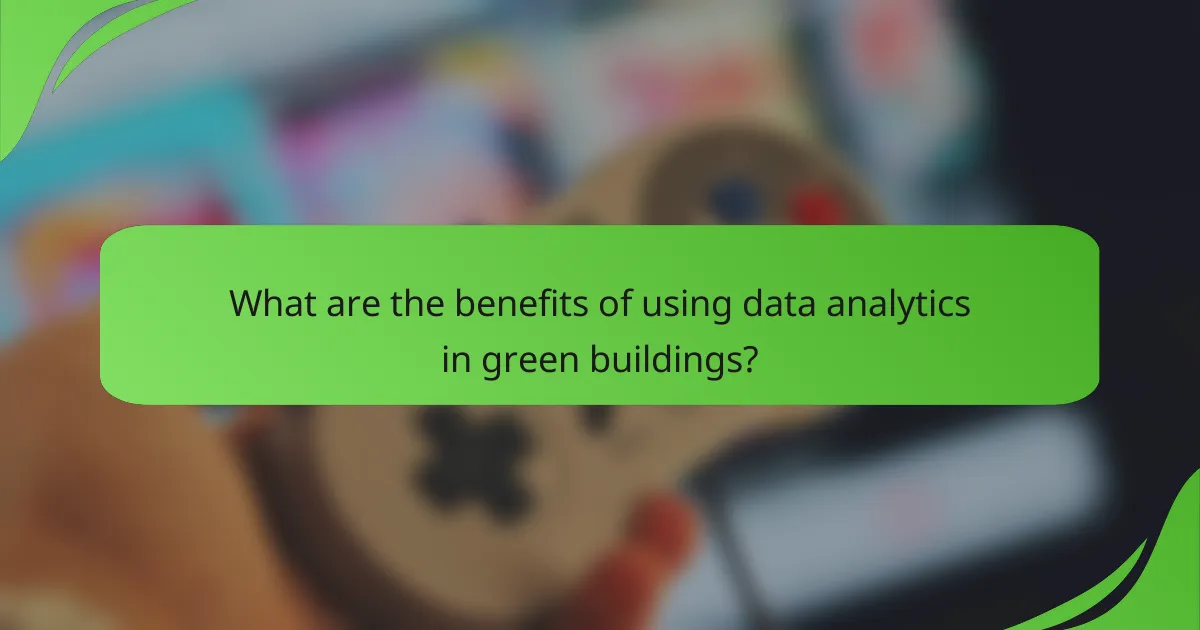Emerging technologies play a crucial role in enhancing the monitoring and management of green buildings by facilitating real-time data collection and advanced energy management. By employing techniques such as predictive analytics and machine learning, these innovations optimize energy consumption and improve overall building performance. Additionally, specialized reporting tools support effective data analysis, ensuring compliance with sustainability standards and promoting efficient resource management.

How can emerging technologies improve monitoring in green buildings?
Emerging technologies enhance monitoring in green buildings by enabling real-time data collection, integration of systems, and advanced energy management. These innovations lead to improved efficiency, reduced operational costs, and better compliance with sustainability standards.
IoT sensors for real-time data collection
IoT sensors play a crucial role in monitoring green buildings by providing real-time data on various parameters such as temperature, humidity, and occupancy. These sensors can be strategically placed throughout a building to gather continuous information, allowing for immediate adjustments to optimize energy use and occupant comfort.
When implementing IoT sensors, consider the types of data most relevant to your building’s operations. For example, occupancy sensors can help manage lighting and HVAC systems more effectively, potentially reducing energy consumption by up to 30% in some cases.
Building Management Systems (BMS) integration
Integrating IoT sensors with Building Management Systems (BMS) allows for centralized control and monitoring of a building’s systems. A BMS can analyze data from various sensors and automate responses, such as adjusting heating or cooling based on occupancy levels.
To maximize the benefits of BMS integration, ensure that the system is compatible with existing technologies and can scale as new sensors are added. Regular updates and maintenance are essential to keep the system functioning optimally and to leverage new features as they become available.
Energy monitoring software solutions
Energy monitoring software solutions provide insights into a building’s energy consumption patterns, helping identify areas for improvement. These tools can track usage over time, compare it against benchmarks, and generate reports that inform decision-making.
When selecting energy monitoring software, look for features such as real-time analytics, customizable dashboards, and integration capabilities with existing systems. Many solutions offer cloud-based options, allowing for remote access and easier collaboration among stakeholders.

What data analysis techniques are effective for green buildings?
Effective data analysis techniques for green buildings include predictive analytics and machine learning, both of which optimize energy consumption and enhance overall building performance. These methods leverage historical data to forecast future trends and improve decision-making in sustainable building management.
Predictive analytics for energy consumption
Predictive analytics involves using historical energy consumption data to forecast future usage patterns. By analyzing past trends, building managers can identify peak usage times and potential areas for energy savings. This technique often employs statistical algorithms to predict energy demands, enabling proactive adjustments to reduce costs.
For example, a building may analyze its energy data to determine that heating needs peak during certain months. By anticipating these peaks, managers can implement strategies such as adjusting HVAC settings or scheduling maintenance during off-peak times, leading to significant energy savings.
Machine learning for performance optimization
Machine learning enhances performance optimization by analyzing vast amounts of data to identify inefficiencies and recommend improvements. This technique can adapt over time, learning from new data inputs to refine its predictions and suggestions. It is particularly useful in monitoring systems like HVAC, lighting, and water usage.
For instance, a machine learning model could analyze real-time data from sensors throughout a building to optimize heating and cooling schedules based on occupancy patterns. By continuously learning from these patterns, the system can reduce energy waste, potentially achieving energy savings of 20-30% over time.

What reporting tools are available for green building performance?
Several reporting tools are designed to help monitor and analyze the performance of green buildings. These tools facilitate data collection, performance tracking, and compliance with sustainability standards, ultimately aiding in energy efficiency and resource management.
EnergyStar Portfolio Manager
EnergyStar Portfolio Manager is a widely used tool for benchmarking energy and water consumption in commercial buildings. It allows users to input data such as energy bills and square footage to generate performance metrics, which can be compared against similar buildings.
This tool helps identify areas for improvement by providing insights into energy usage patterns. Users can track performance over time and set goals for energy reduction, making it easier to achieve sustainability targets.
LEED Online for certification tracking
LEED Online is the platform used for managing the certification process of buildings under the Leadership in Energy and Environmental Design (LEED) program. It provides a structured approach to document and track compliance with LEED standards throughout the project lifecycle.
Users can upload necessary documentation, monitor progress, and communicate with project teams. The platform also offers resources to help navigate the certification process, ensuring that all requirements are met efficiently.

What are the benefits of using data analytics in green buildings?
Data analytics in green buildings enhances sustainability by optimizing energy use and resource management. This approach leads to improved operational efficiency, reduced environmental impact, and cost savings over time.
Enhanced energy efficiency
Data analytics enables real-time monitoring of energy consumption patterns in green buildings. By analyzing this data, facility managers can identify inefficiencies and implement strategies to optimize energy use, such as adjusting HVAC systems or improving insulation.
For instance, smart sensors can track occupancy levels and adjust lighting accordingly, leading to energy savings of 20-30%. Regular analysis of energy data can also help in meeting local energy efficiency standards and regulations.
Cost savings through optimized resource use
Utilizing data analytics allows green buildings to optimize resource allocation, resulting in significant cost savings. By understanding usage trends, managers can reduce waste and improve the efficiency of water, electricity, and other resources.
For example, predictive analytics can forecast maintenance needs, preventing costly repairs and downtime. Implementing these practices can lead to overall operational cost reductions of 10-15%, making green buildings not only environmentally friendly but also economically viable.

How do local regulations impact green building technologies?
Local regulations significantly influence the adoption and implementation of green building technologies by establishing mandatory standards and guidelines. These regulations can dictate energy efficiency requirements, sustainable material usage, and overall building performance, impacting both design and operational costs.
Compliance with energy efficiency standards
Compliance with energy efficiency standards is crucial for green buildings, as it ensures that structures meet minimum performance criteria. Regulations often include specific benchmarks for energy consumption, such as the International Energy Conservation Code (IECC) in the United States or the Energy Performance of Buildings Directive (EPBD) in the European Union.
Building owners should regularly review local energy codes to ensure compliance. Non-compliance can lead to penalties and increased operational costs. Consider conducting energy audits to identify areas for improvement and align with local standards.
Incentives for sustainable practices
Many local governments offer incentives for sustainable practices in green building projects, such as tax credits, grants, or expedited permitting processes. These incentives can significantly reduce upfront costs and encourage the adoption of energy-efficient technologies.
For example, in the U.S., the Energy Policy Act provides tax deductions for energy-efficient commercial buildings. It is advisable to research available local incentives and integrate them into project planning to maximize financial benefits while promoting sustainability.

What are the emerging trends in green building technologies?
Emerging trends in green building technologies focus on enhancing energy efficiency, sustainability, and occupant comfort through innovative solutions. Key developments include the integration of artificial intelligence (AI) in building operations and advancements in renewable energy systems.
Integration of AI in building operations
The integration of AI in building operations optimizes energy use and improves overall efficiency. AI systems can analyze data from various sensors to adjust heating, cooling, and lighting in real-time, ensuring optimal conditions while minimizing energy consumption.
Building managers can implement AI-driven platforms to predict maintenance needs, reducing downtime and costs. For example, predictive analytics can identify when HVAC systems require servicing, potentially saving thousands in energy bills and repairs.
Advancements in renewable energy systems
Advancements in renewable energy systems are crucial for achieving sustainability in green buildings. Technologies such as solar panels, wind turbines, and geothermal systems are becoming more efficient and cost-effective, making them accessible for various building types.
For instance, solar photovoltaic systems can now generate energy even in low-light conditions, while battery storage solutions allow buildings to store excess energy for later use. Incorporating these systems can significantly reduce reliance on fossil fuels and lower operational costs over time.
